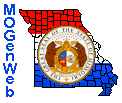
If you have any comments concerning these materials please send e-mail to John Slavin at jslavin@marktwain.net.

As people began to settle in America, they quickly realized the limitations with the traditional metes and bounds system. The map below gives an example of a metes and bounds plat. (On this and all maps, if you click on the map, it will take you to a much larger map of the same subject.)
In the late 1700s and early 1800s, a system was established wherein a uniform grid formed the framwork for land transactions. The grid was tied to one of several Base Lines, which run east and west, and Meridian lines, which run north and south. In Scotland County, the legal descriptions are tied to the Base Line in Arkansas, so all descriptions are north of that line and West of the the 5th Principal Meridian Line, which is just across the Mississippi River in Illinois. The following map shows the Base Lines and Meridian Lines in the United States at the end of the 19th century.
Legal descriptions in Scotland County, Missouri, are measured north from the Base Line and west of the Meridian Line, every six miles. These lines are called Township Lines (relative to the Base Line) and Range Lines (relative to the Meridian Line).
In Scotland County, for example, the map in the southeast corner of the county is for Township 64 North and Range 10 West. This means that it is the 64th six-mile line measured up from the Base line, and the 10th Range line measured west of the 5th Principal Meridian Line.
The following map shows how Township and Range lines are established.
Two Township and two Range Lines form a box. The box is six miles on each side. When the box is divided into the mile divisions, they form the sections shown on all the maps. The conventional method for numbering the sections is to begin in the upper right corner and then number across to the left, down one, then across to the right, down one and back to the left, etc.
The curviture of the earth, however, presents a problem. As we all know, the earth is not a cube, so some adjustment had to be made. The standard method of making the adjustments are in the sections on the west and north sides.Since the quarter sections do not represent conventional sizes, they are instead refered to as "lots." These are not lots like city lots, but are section lots. The following diagrams shows how sections are established.
A standard section contains 640 acres. Thus a quarter section contains 160 acres and a fourth of that (a quarter quarter section) is a 40 acre tract. Sections can be divided in other divisions, some of which are much less common. The following diagram shows how sections of often divided.